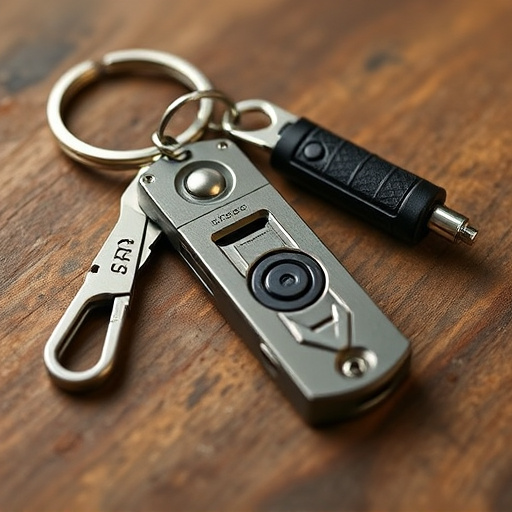While seemingly harmless, keychains can be classified as prohibited weapons due to their design or functionality, as outlined in the Prohibited Keychain Weapons List. This list includes various tools like pocket knives, tasers, stun guns, and specific flashlights. The protection keychain, a stylish personal defense tool, offers blunt force capabilities, LED lights, bottle openers, and discreet mechanisms for self-defense. However, understanding local regulations is crucial to avoid legal issues when purchasing or carrying such keychains. Users must be trained in their use to prevent accidents. The list of prohibited weapons varies by region, focusing on tools capable of causing serious harm. When choosing a defense tool, consider reach, ease of use, and weight for discretion and practicality.
“Uncover the world of self-defense keychains, especially those designed to mitigate blunt force trauma. This comprehensive guide explores prohibited keychain weapons and their legal implications, offering a critical resource for individuals seeking personal safety. We dissect the design and functionality of protection keychains, providing insights into their effectiveness.
Furthermore, we offer expert tips on choosing the right defense, ensuring you’re equipped with the best self-defense tool. Discover the ultimate list of prohibited keychain weapons to stay informed and prepared.”
- Understanding Prohibited Keychain Weapons: A Comprehensive List
- The Design and Functionality of Protection Keychains
- Legal Implications and Safety Considerations
- Choosing the Right Defense: Tips for Selecting a Protective Keychain Weapon
Understanding Prohibited Keychain Weapons: A Comprehensive List
Keychains are often seen as simple accessories, but some can serve as potential weapons, leading to legal complications. It’s crucial to understand what constitutes a prohibited keychain weapon, as defined by various laws and regulations. This comprehensive list covers a range of items that, due to their design or functionality, are restricted for carrying in public places.
The Prohibited Keychain Weapons List includes any device with a blade or sharp edge designed to cause injury, such as pocket knives, switchblades, and certain multi-tool keychains. Additionally, items like tasers, stun guns, and pepper spray keychains are also banned in many jurisdictions. Some countries and states even prohibit keychains with built-in flashlights if they have a specific design or power level that could be considered dangerous. Understanding this list is essential for anyone considering carrying a keychain for self-defense purposes to ensure compliance with local laws and avoid legal repercussions.
The Design and Functionality of Protection Keychains
The protection keychain, a sleek and innovative device, combines style with safety, offering a unique solution for personal defense. Its design typically features a small, portable form factor, easily fitting into one’s pocket or bag. Crafted from durable materials like metal or high-quality plastic, these keychains are more than just ornamental; they serve as powerful tools to deter potential threats. The keychain’s functionality lies in its ability to act as a blunt force weapon, designed to disrupt an assailant’s grip on their weapon or cause temporary incapacitation through pain compliance.
This handy self-defense accessory comes with a range of features catering to various needs. Some models incorporate LED lights for visibility during low-light situations, while others include emergency tools like bottle openers or window breakers. Additionally, the keychain’s design often incorporates discreet yet effective mechanisms, ensuring it remains hidden yet readily accessible when needed. With its compact size and versatile functionality, the protection keychain is a smart choice for individuals seeking to carry a concealed personal defense tool, offering peace of mind in an easy-to-carry package that includes a comprehensive Prohibited Keychain Weapons List for users to stay informed.
Legal Implications and Safety Considerations
When considering a protection keychain with blunt force tips, it’s crucial to understand the legal implications and safety considerations involved. The use and possession of self-defense tools like keychains designed for blunt force are regulated by local laws, which vary significantly from one jurisdiction to another. Some regions have specific prohibitions on certain types of self-defense weapons, including those that might fall under the category of “prohibited keychain weapons list.” It’s essential to research and comply with these regulations to avoid legal repercussions.
Safety is paramount when carrying any form of self-defense device. While a protection keychain may offer some level of security, it should never be relied upon as the sole means of defense. Users must be trained in their proper use and understand the potential consequences of misuse or accidental deployment. Additionally, keeping such devices out of reach of children and securing them properly can help prevent accidents or inappropriate use.
Choosing the Right Defense: Tips for Selecting a Protective Keychain Weapon
When selecting a protective keychain weapon, understanding what constitutes a prohibited keychain weapon is crucial. Many countries and regions have specific laws governing the types of self-defense tools allowed, so it’s essential to check local regulations before making a purchase. The prohibited keychain weapons list typically includes items that are designed or capable of causing serious harm, such as knifes with blades longer than a certain length, tactical pens with sharp tips, or any device that can be used as a club or battering ram.
To choose the right defense, consider factors like the weapon’s reach and ease of use. A shorter blade or blunt force tip might be more suitable for close-quarters protection, while longer blades could offer better distance. Additionally, look for lightweight designs that won’t add significant bulk to your keychain, ensuring it remains practical for everyday carry. Remember, the goal is to have a discreet and easily accessible tool for self-defense without drawing unnecessary attention or violating any laws.
In light of the diverse range of prohibited keychain weapons outlined in our comprehensive list, understanding their design, functionality, and legal implications is crucial for personal safety. By equipping yourself with a well-chosen protective keychain weapon, you can enhance your self-defense capabilities while navigating potential threats. Remember that knowledge and preparation are key; always stay informed about local laws regarding self-defense tools and choose a defense mechanism that suits your needs effectively.
